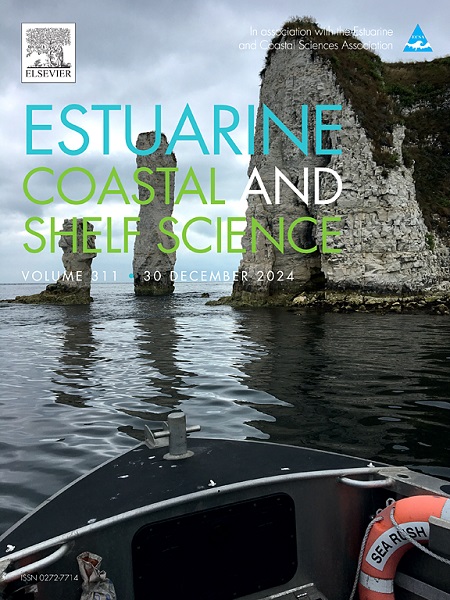On the magnitude and mechanisms of occurrence of nonlinear tide-surge interactions in the Southwestern Atlantic Continental Shelf
IF 2.6
3区 地球科学
Q1 MARINE & FRESHWATER BIOLOGY
引用次数: 0
Abstract
This paper aims to characterise the nonlinear tide-surge interactions (NTSIs) and their impact on the Southwestern Atlantic Continental Shelf (SWACS) barotropic dynamics. In addition, the associated atmospheric configuration, the generation mechanisms and their long-term variability were also studied. For it, process oriented numerical simulations with realistic geometry and bathymetry which consider the effect of atmospheric and tidal forcing both individually and jointly are run. Results reveal that NTSIs are significant in the shallower areas (depth less than 50 m) of the SWACS where both the tide and the surge present comparable magnitudes. North of 40°S, where shallow areas are relatively extensive, NTSI can account for between 5 and 40% of the total sea surface height anomaly which, in turn, is related to a reduction of the resulting sea level anomaly. In agreement, the bottom friction term was found to be the main source of NTSI explaining the loss of energy in shallow areas. In turn, the NTSI is modulated by both the tide and the surge: due to the relatively high frequency of the tide with respect to that of the surge, there are moments when the tidal and surge currents are aligned (opposed), increasing (reducing) the magnitude of the bottom friction and, thus, the NTSI. NTSIs in the SWACS can be described in terms of two spatial modes: one is strongly modulated by the surge and occurs when storm surges affect the Río de la Plata (microtidal) estuary; the second one is weaker and affects the northern SWACS coast where tides become larger and is mixed modulated by the tide and the surge. The first mode occurs in association with atmospheric Rossby waves that travel along 45°S, which are efficient in producing the winds that force the resonant response of the estuary forcing a locally generated surge; the second mode is related to atmospheric Rossby waves that travel south of 45°S, which are more efficient in generating surges in the SWACS. Both modes are found to show pseudo-periodicities on the interannual time scale in a band centred at around 2.5 years, which is consistent with the known scales of surge variability. Finally, results highlight the need to use regional tide-surge coupled models to forecast the surge in the SWACS; otherwise the estimation errors could be very large in some coastal and shallow regions due to misrepresentation of the barotropic regional dynamics.
西南大西洋大陆架非线性潮涌相互作用的幅度和发生机制
本文研究了西南大西洋大陆架非线性潮浪相互作用及其对西南大西洋大陆架正压动力学的影响。此外,还研究了相关的大气结构、产生机制及其长期变率。为此,进行了考虑大气强迫和潮汐强迫单独或共同作用的、具有真实几何和水深特征的过程导向数值模拟。结果表明,在SWACS的较浅区域(深度小于50 m),潮汐和浪涌都具有相当的强度,ntsi显著。在40°S以北,浅层区域相对广泛,NTSI可占总海面高度异常的5%至40%,这反过来又与由此产生的海平面异常减少有关。在一致的情况下,底部摩擦项被发现是解释浅层区域能量损失的NTSI的主要来源。反过来,NTSI受到潮汐和浪涌的调制:由于潮汐相对于浪涌的频率相对较高,有潮汐和浪涌电流对齐(相反)的时刻,增加(减少)底部摩擦的大小,从而增加(减少)NTSI。SWACS中的ntsi可以用两种空间模式来描述:一种是由风暴潮强烈调制的,发生在风暴潮影响Río de la Plata(微潮)河口时;第二个较弱,影响SWACS北部海岸,那里的潮汐变大,并受到潮汐和浪涌的混合调制。第一种模式与沿45°S传播的大气罗斯比波有关,这种波有效地产生了迫使河口产生共振反应的风,从而产生了局部产生的浪涌;第二种模式与在45°S以南传播的大气罗斯比波有关,这种波在SWACS中更有效地产生浪涌。这两种模态在年际时间尺度上都表现出伪周期性,以2.5年为中心,这与已知的浪涌变率尺度一致。最后,研究结果强调需要使用区域潮-浪耦合模型来预测SWACS的浪涌;否则,在一些沿海和浅海地区,由于对正压区域动力学的错误表述,估计误差可能很大。
本文章由计算机程序翻译,如有差异,请以英文原文为准。
求助全文
约1分钟内获得全文
求助全文
来源期刊
CiteScore
5.60
自引率
7.10%
发文量
374
审稿时长
9 months
期刊介绍:
Estuarine, Coastal and Shelf Science is an international multidisciplinary journal devoted to the analysis of saline water phenomena ranging from the outer edge of the continental shelf to the upper limits of the tidal zone. The journal provides a unique forum, unifying the multidisciplinary approaches to the study of the oceanography of estuaries, coastal zones, and continental shelf seas. It features original research papers, review papers and short communications treating such disciplines as zoology, botany, geology, sedimentology, physical oceanography.

 求助内容:
求助内容: 应助结果提醒方式:
应助结果提醒方式:


